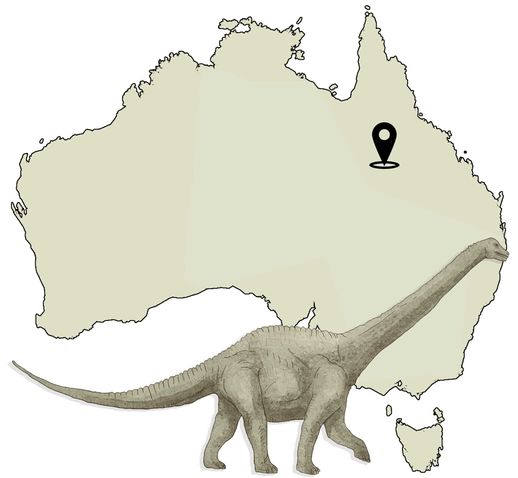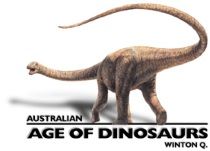Diamantinasaurus matildae

Di-ah-man-teen-ah-sore-us mah-till-day
Meaning
[Waltzing] Matilda’s (from the Banjo Paterson song which was written and first performed in the Winton area) Diamantina [River] lizard
Period
Middle Cretaceous (100–95 Mya)
Discovery and publication
Found on Elderslie station (near Winton), Queensland, in 2005 by the property owner, Sandra Muir. The site was dubbed the “Matilda” site and was excavated by the Australian Age of Dinosaurs Museum of Natural History from 2006–2010. Diamantinasaurus was named and described in 2009 by Dr Scott Hocknull and others, with a revised description of newly prepared specimens in 2015 by Dr Stephen Poropat and again in 2024 by Samantha Beeston and others. The remains of this sauropod were found intermingled with the theropod Australovenator, as well as bones of crocodylomorphs and turtles, lungfish tooth plates, and isolated bivalves.
Description
Diamantinasaurus was established on the basis of a skeleton (nicknamed “Matilda”) which preserves both forelimbs, the right hind limb, the shoulders and pelvis, and several back vertebrae and ribs. Approximately 30% of the skeleton of “Matilda” has been recovered, making it the most complete Cretaceous sauropod ever found in Australia (only the Jurassic-aged Rhoetosaurus comprises a greater quantity of material). Diamantinasaurus is unique among Australian sauropods, and somewhat of a rarity among sauropods worldwide, because its bones were found scattered and intermingled with those of a theropod dinosaur, now known as Australovenator.
At the shoulder, Diamantinasaurus would have been 2.5m tall and, based on comparisons with other related sauropods from around the world, Diamantinasaurus was probably 16m long, with a robust build and a long neck and tail. A reassessment of Diamantinasaurus’ place on the sauropod family tree suggests that it was a titanosaur, and therefore the most derived sauropod yet found in Australia.
Sauropods from the titanosauriform group would typically have had small heads and delicate, pencil-like teeth, big nostrils, broad shoulders and somewhat narrower hips, robust forelimbs with elongate metacarpals (the “palm” of the hand), and a reduced number of bones in each "finger". Some advanced titanosaurs had bony plates in their skin called osteoderms; however, no titanosaur osteoderms have yet been found in Australia (despite a mistaken report). No osteoderms were found with the Diamantinasaurus skeleton either, suggesting that this sauropod lacked them.
Another Diamantinasaurus specimen, nicknamed “Alex”, was found at the Elliot site in 2004, but was not officially recognised as a Diamantinasaurus until 2016. Although “Alex” was smaller than “Matilda”, anatomically it is nearly identical. Importantly, “Alex” preserves bones not present in the “Matilda” specimen, including bones from the neck. However, the most exciting part of “Alex” is a large piece of the skull known as the braincase, which allows scientists to investigate the shape of the brain. This was the first sauropod skull material described from Australia.
In 2022 the third specimen of Diamantinasaurus matildae was described, known as "Oliver". This specimen is the first juvenile sauropod described from Australia, suggesting that Diamantinasaurus exhibited an allometric growth pattern, with limb bones growing at a faster rate than other skeletal elements.
In 2023 Dr Stephen Poropat and colleagues described the fourth specimen, named "Ann". This specimen includes nearly the entire left side of the skull, making it the most complete sauropod skull in Australia. Additionally, "Ann" preserves the first hind foot of a "Diamantinasaurus".
In 2024 research led by Samantha Beeston and others described two additional specimens of Diamantinasaurus, known as "Ian" and "Devil Dave", making it one of the most well-understood species of Australian dinosaur.
